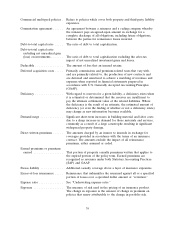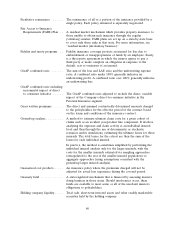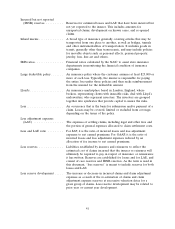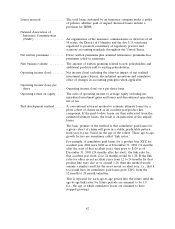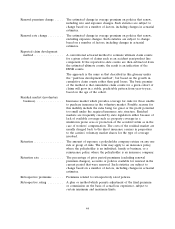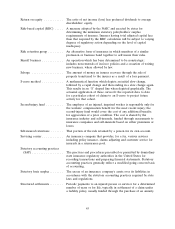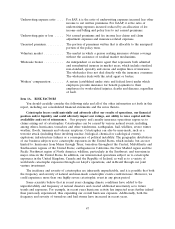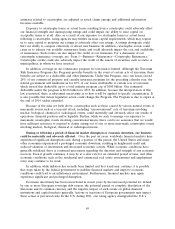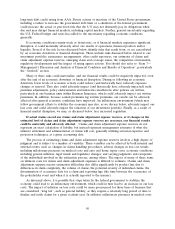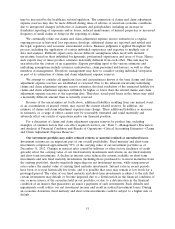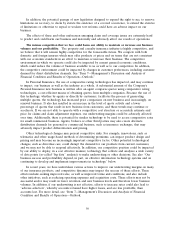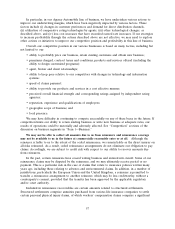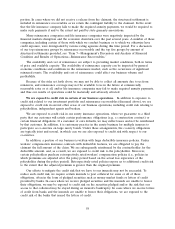Travelers 2012 Annual Report Download - page 61
Download and view the complete annual report
Please find page 61 of the 2012 Travelers annual report below. You can navigate through the pages in the report by either clicking on the pages listed below, or by using the keyword search tool below to find specific information within the annual report.estimates related to catastrophes are adjusted as actual claims emerge and additional information
becomes available.
Exposure to catastrophe losses or actual losses resulting from a catastrophe could adversely affect
our financial strength and claims-paying ratings and could impair our ability to raise capital on
acceptable terms or at all. Also, as a result of our exposure to catastrophe losses or actual losses
following a catastrophe, rating agencies may further increase capital requirements, which may require
us to raise capital to maintain our ratings or adversely affect our ratings. A ratings downgrade could
hurt our ability to compete effectively or attract new business. In addition, catastrophic events could
cause us to exhaust our available reinsurance limits and could adversely impact the cost and availability
of reinsurance. Such events can also impact the credit of our reinsurers. For a discussion of our
catastrophe reinsurance coverage, see ‘‘Item 1—Business—Reinsurance—Catastrophe Reinsurance.’’
Catastrophic events could also adversely impact the credit of the issuers of securities, such as states or
municipalities, in whom we have invested.
In addition, coverage in our reinsurance program for terrorism is limited. Although the Terrorism
Risk Insurance Program (the Program) provides benefits in the event of certain acts of terrorism, those
benefits are subject to a deductible and other limitations. Under this Program, once our losses exceed
20% of our commercial property and casualty insurance premium for the preceding calendar year, the
federal government will reimburse us for 85% of our losses attributable to certain acts of terrorism
which exceed this deductible up to a total industry program cap of $100 billion. Our estimated
deductible under the program is $2.26 billion for 2013. In addition, because the interpretation of this
law is untested, there is substantial uncertainty as to how it will be applied to specific circumstances. It
is also possible that future legislative action could change the Program. The Program is due to expire at
the end of 2014, unless extended.
Because of the risks set forth above, catastrophes such as those caused by various natural events or
man-made events such as a terrorist attack, including ‘‘unconventional’’ acts of terrorism involving
nuclear, biological, chemical or radiological events, could materially and adversely affect our results of
operations, financial position and/or liquidity. Further, while we seek to manage our exposure to
man-made catastrophic events involving conventional means, there can be no assurance that we would
have sufficient resources to respond to claims arising out of one or more man-made catastrophic events
involving nuclear, biological, chemical or radiological means.
During or following a period of financial market disruption or economic downturn, our business
could be materially and adversely affected. Over the past six years, worldwide financial markets have
experienced significant disruptions and, during a portion of this period, the United States and many
other economies experienced a prolonged economic downturn, resulting in heightened credit risk,
reduced valuation of investments and decreased economic activity. While economic conditions have
generally stabilized, there is continued uncertainty regarding the duration and strength of any economic
recovery. Even if growth continues, it may be at a slow rate for an extended period of time, and other
economic conditions, such as the residential and commercial real estate environment and employment
rates, may continue to be weak.
In addition, while inflation has recently been limited and that trend may continue, it is possible
that steps taken by the federal government to stabilize financial markets and improve economic
conditions could lead to an inflationary environment. Furthermore, financial markets may again
experience significant and prolonged disruption.
Economic uncertainty has been exacerbated in recent years by the increased potential for default
by one or more European sovereign debt issuers, the potential partial or complete dissolution of the
Eurozone and its common currency and the negative impact of such events on global financial
institutions and capital markets generally. Actions or inactions of European governments may impact
these actual or perceived risks. In the U.S. during 2011, one rating agency downgraded the U.S.’s
49


